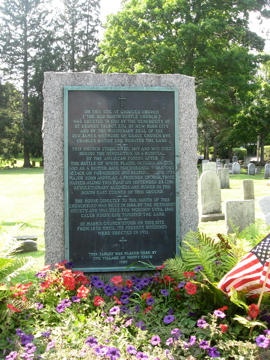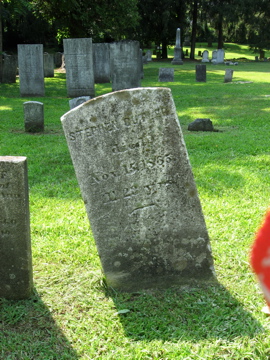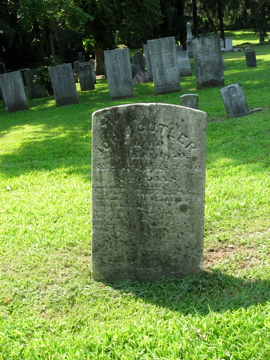There are multiple records indicating several relatives of the Yerk’s family are buried here, at St. Georges Cemetery in Mount Kisco. The headstones are heavily worn, but still read with the name “Cutler”.
In 1761, a mission church, then called Saint George’s (now St. Mark’s), was established on a plot of ground across the street from the current Friendly’s Restaurant on East Main Street, just south of the Northern Westchester Hospital complex. (The area was then referred to as North Castle, explaining early references to “Saint Mark’s North Castle” as opposed to “Saint Mark’s Mount Kisco.”)
St. Mark’s was formally recognized as a religious corporation in New Castle in 1850, largely through the efforts of the Reverend R. M. Harris, rector of Grace Church, White Plains.
A new church was built on the site of the earlier Saint George’s which was sold in 1819 due to extensive damage from Revolutionary War battles. According to records, the new building was a “model for a country church, 50 by 30 feet with a tower projecting 8 feet in front.” Exclusive of stained glass and the furniture, it cost $2,050. The burying ground, which was in back of Saint George’s and then St. Mark’s, remains to this day. It contains graves dating back to the Revolutionary War.
During the Revolutionary War, New and North Castle were officially considered neutral territory. However, the area was strongly patriotic. One significant Revolutionary War conflict did occur in North Castle – The Battle of White Plains. This battle of October 28, 1776 was a series of short skirmishes between General Washington’s small American army and General William Howe’s much largerBritish & Hessian force. Although the British eventually won the confrontation, forcing Washington’s troops to retreat, Howe never followed up this advantage by pursuing and capturing the American army. Thus, the battle served as a delaying action that allowed Washington’s troops to withdraw to safety in New Jersey. As a result, many historians feel that the battle marked an important turning point in the war.
One other important Revolutionary War event occurred in the North Castle area involving the infamous British spy, Major John Andre. In December 1780, Major Andre was captured in Tarrytown by American soldiers. Upon searching Andre they found concealed documents from American General Benedict Arnold that contained secret plans of West Point. Upon his arrest, Andre was first held in Thomas Wright’s Mills (later known as Sands’ Mills) at Mile Square. A month later Andre was hanged for treason.
The Elijah Miller house in North White Plains was several times the headquarters of General George Washington during the Revolutionary War. A few miles to the west (in present-day Mount Kisco) St. George’s Church (or North Castle Church) served as a camp and hospital. A young Frenchman’s diary dated July 6, 1781, reported of the area:
This whole country gives evidence of the horrors of war… All the Whigs here have abandoned their houses. Among them are some very handsome ones, deserted, half destroyed, or burned, with untended orchards and gardens filled with fruits and vegetables and driveways overgrown with grass two feet high







